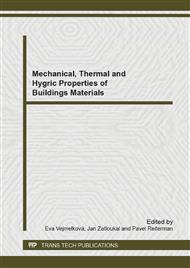p.68
p.74
p.79
p.84
p.90
p.94
p.100
p.104
p.108
Heat and Water Vapor Transport Properties of Selected Commercially Produced Plasters
Abstract:
Although plaster belonged to the first structural materials, they are still getting further enhancements. Nowadays different companies are producing and selling plasters that differ either in their composition or purpose. This article is comparing plasters presented on the market in the Czech Republic. Those are lightweight, renovation and even most common lime-cement plasters. Among the studied characteristics were: basic physical properties (for comparison were measurement of two methods: vacuum water saturation and helium pycnometry); they water vapor transport parameters and heat transport parameters. Lightweight and renovation plasters had shown the biggest porosity, lowest thermal conductivity and the highest diffusion resistance factor.
Info:
Periodical:
Pages:
90-93
Citation:
Online since:
July 2014
Keywords:
Price:
Сopyright:
© 2014 Trans Tech Publications Ltd. All Rights Reserved
Share:
Citation:


